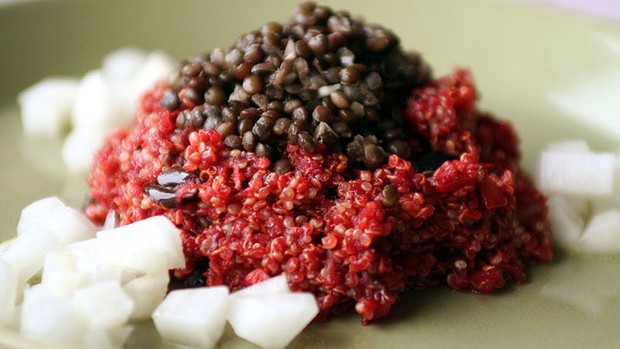
Beluga lentils glisten when they're cooked, which makes them look like beluga caviar.
Every year a number of food trends emerge that have foodies around the world in a fluster. Last year the ancient South American grain quinoa rose to fame and leafy green veggie Kale was hailed as a must-eat, while black garlic and chia seeds were also ranked high among the culinary cool kids.
This year is no different, so here are the top 10 "superfoods" we can expect to see gracing menus, supermarkets, health food stores and dinner tables.
Buffalo berries
This bright tart-tasting fruit is native to northern and western America, and has historically been used by the North American indigenous people. Bursting with lycopene (the pigment found in red fruits and vegetables such as tomatoes), it is said to have antioxidant properties that can help protect against cell damage at the molecular level, as well as potential anti-inflammatory effects.
Beluga lentils
It is the black anthocyanins in these little grains of goodness that have been found to be excellent in the fight against inflammation, some cancers and heart disease.
Shichimi togarashi
This Japanese spice is set to take over our tastebuds in 2014. Traditionally, this is a blend of a number of different spices including orange or tangerine peel, black and white sesame seeds, chilli powder and seaweed.
What makes this spice so special is that it is salt free, awesome with fish, chicken or noodles, chock full of antioxidants and is said to help lower blood pressure and heart disease.
Salsify (oyster plant)
Move over kale, this root vegetable could easily become a favourite on menus and dinner plates around the world. It is high in fibre, low in calories and is believed to help in keeping belly fat and weight down.
Teff
Coeliacs and those who are gluten intolerant can rejoice as another grain moves into market. Teff is high in calcium and vitamin C, and tastes really good. However, what will make this a must-have ingredient is that up to 40 per cent of the teff grain is considered a resistant starch, which means starch you can't digest.
A study conducted last year found that a diet high in resistant starches could help prevent IBS and colorectal cancers.
It is still a little difficult to find in Australia, but is available at some specialised health food outlets.
Canary seeds
A new kind of canary seed is on the block. Last year a study found a new variety of these seeds that have been de-hulled for our consumption. They are not only gluten free, but also have more protein than other gluten-free grains such as millet and corn. Yet another score for the coeliacs and gluten intolerant.
The seeds can also be pulverised and used as a flour.
Tempeh (fermented soybean)
Bad gut health, when harmful bacteria lingers, has been linked to the formation of autoimmune diseases and increased risk of diabetes.
In Chinese astrology, 2014 may be the year of the horse, but where food is concerned it will be the year of the gut.
One way of getting good bacteria into you is by consuming fermented foods such as tempeh, which could help with digestion and obesity, and ease the effects of stress.
Za'atar
If you're familiar with Middle Eastern cuisine, this may not be entirely new. For the rest of us this yummy spice blend of sumac seeds, salt, sesame seeds and thyme is fantastic for marinades. This sumptuous spice is also said to assist in reducing the risk of contracting food-borne illnesses.
Hemp hearts (hulled hemp seeds)
It might sound strange but hemp hearts are packed full of good fatty acids, proteins and B vitamins. They have a nutty, crunchy texture and are great toppers for cereals, salads or yoghurts.
Kimchi
A staple classic in Korean cuisine, this pickled, spicy, sour cabbage dish has been gaining momentum in the US.
Yet another fermented food, it's good for your gut and one study also showed that those who ate the fermented kimchi over the fresh variety for one month had an improvement in cholesterol and blood pressure and lost more weight.






















